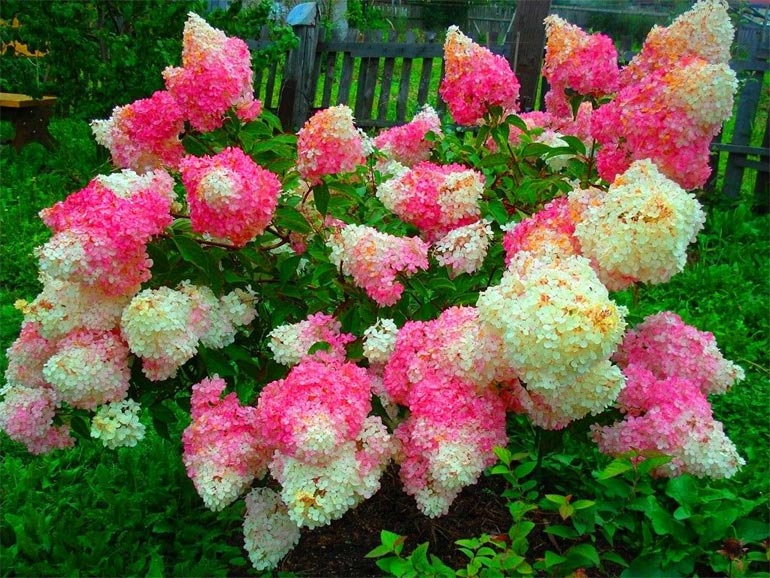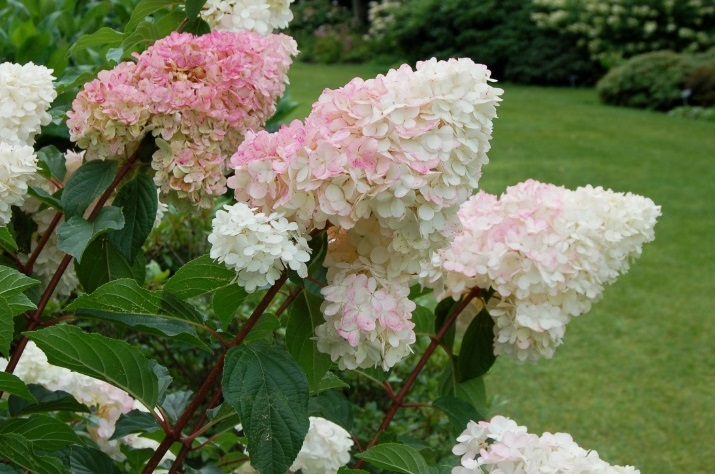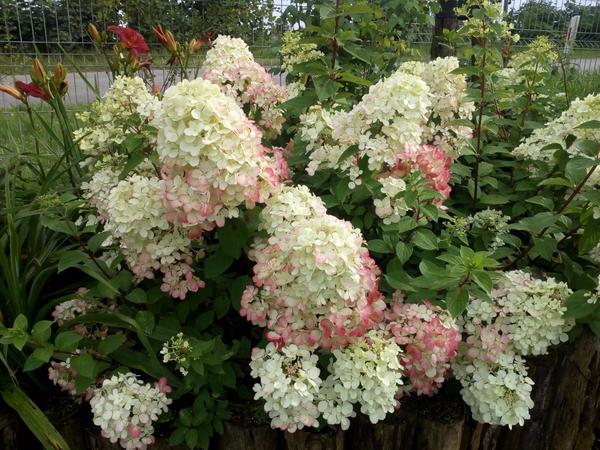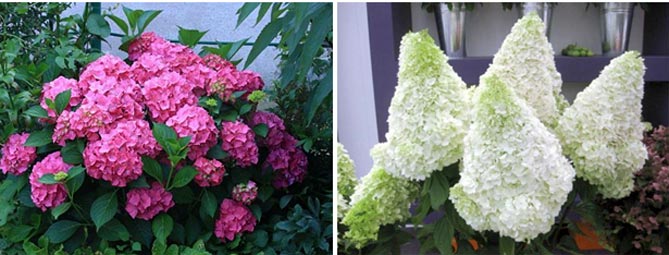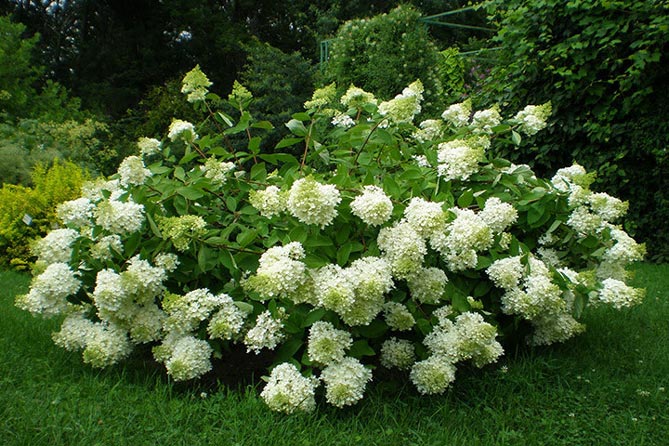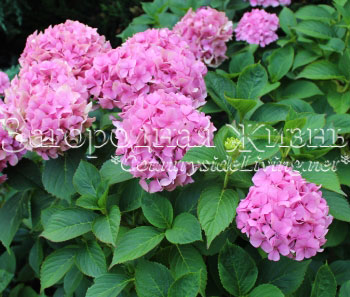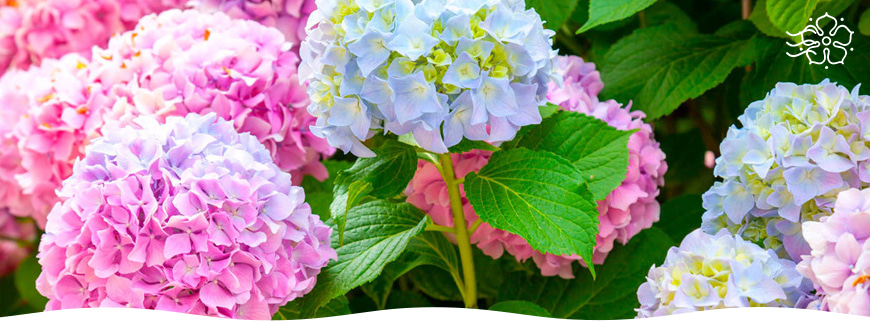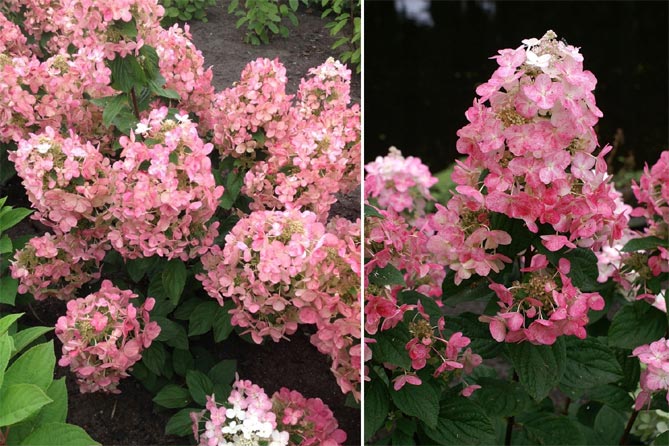Botanical description

Leaves
Leaves
Hydrangea paniculata is a deciduous woody plant with jagged leaves arranged in opposite pairs or groups of three and flower heads consisting of showy, sterile flowers mixed with smaller, fertile ones. The difference from other species is the structure of the inflorescence, usually a conical panicle. The only other type of hydrangea, in which flowers are located in a panicle, is a tree hydrangea, characterized by the presence of lobed leaves.
Size: in the wild, a shrub reaches 2 m or a small tree up to 8 m.
Shoots: very brittle. Fluffy at first, then not pubescent.
Leaves: elliptical or ovoid, toothed, pointed, rounded or pointed at the base, 7.5-15 cm long and about half the length in width. Arranged in opposite pairs or in 3. The veins and the lower part of the leaf are rarely pubescent.
Flowers: a mixture of small, yellowish, fertile and sterile flowers with 4-5 white sepals, usually whole, often changing color to pink or purplish pink, especially on the underside. The flowers open from the base to the top of the panicle.
Fruits: capsule with numerous seeds. Seeds germinate in 2-4 weeks.
Description
The Pinky Winky panicle hydrangea is a perennial deciduous shrub that can reach a height of 1.5-2 m. It belongs to the Hydrangea family, the species Hydrangea paniculata (panicle hydrangea).

Pinkie Winky hydrangea appearance
The description of the plant looks like this:
- The crown is rounded, the width is approximately equal to the height.
- The root system is superficial, extending beyond the crown.
- Growth rates - the annual growth is 20-25 cm. In the first years, the growth of shoots is not very fast, but as the bush matures, the intensity and speed increase.
- Flowering - annually, on the shoots of the current year.
- The best time to plant is spring.
- Soil acidity - 5.5-6 pH.
- The structure of the soil is light, breathable, nutritious.
- Reproduction - by dividing the bush, cuttings, branches.
- The peak of decorativeness is from July to September.
- Shoots - slightly pubescent, brownish-red color. Elastic, do not bend under the weight of flowers, can do without supports.
- The color of the leaf plates is rich green, in autumn with an interspersed reddish tones.
- The shape of the leaf plates is ovoid, with a wide base and a pointed edge, 10 cm long.
- Flowers - dense dense panicles, cone-shaped, 20-25 cm long and with a base of 15 cm.
- The color of the inflorescences is white, gradually changing to pink and then red colors.
Due to the gradual blooming of flowers on the brushes, Pinky Winky hydrangea is colored simultaneously in all the listed colors.

Inflorescence close-up
Description of Pinkie Winky hydrangea
This garden shrub attracts attention with its unusual appearance and pleases the eye. Among dozens of artificially bred varieties, this variety stands out for its high decorative properties.
Hydrangea flowers have an unusual color that changes during the flowering period. Freshly blossomed inflorescences are white, then they gradually turn pink and dark red. At the same time, the growth of inflorescences continues, and on one brush you can see flowers of different colors - white at the crown, pink in the middle and dark, crimson-red, below;
This hydrangea variety blooms for five months - from June to the end of October (until the first frost);
The shrub grows rapidly, its shoots are annually lengthened by 25-35 centimeters. An adult plant reaches a height of 1.7 to 2 meters;
The dark green leaves of the shrub turn crimson red in September. At this time of the year, the plant looks especially picturesque;
The plant has strong branches, its crown does not fall apart under the weight of heavy flowers, a properly cut bush always retains a pyramidal shape;
Hydrangea Pinky Winky grows well both in the south and in central Russia. It is grown even in the south of Siberia, but in this case, the plant is planted in a container, which is transferred to the cellar for the winter.
Care features
The Diamant variety does not require special care. It is enough to know the basic rules for handling hydrangea, then it will grow beautifully.

For a hydrangea to be luxuriantly in color, it needs at least minimal maintenance.
Shrub pruning
Hydrangea Pink Diamond, like any other plant, needs timely pruning. This not only gives the bush an aesthetic appearance, but also allows it to grow even more lush.
The main pruning takes place in the spring. Deleted:
- dead shoots;
- damaged branches;
- strongly protruding shoots.
For your information! It is necessary to thin out the crown from time to time. The procedure is carried out in the fall.
Watering
Diamond during growth needs abundant watering. Therefore, in the early stages, watering should be done often in order to exclude possible drying out.
By following simple rules, the shrub will bloom and smell. Necessary:
- with frequent rains, water once a month with a pair of buckets of water;
- in case of rare rains, water 2-3 buckets every week;
- in dry weather, water 2 times a week.
Watering must be done carefully, as excessive moisture damages the plant.
Top dressing and fertilization
An important measure in the care of this hydrangea of this variety is feeding. As with watering, you need to actively feed it in the spring. Organic and mineral additives are used as fertilizers. Feeding can be divided into three stages:
- in the spring, use saltpeter, peat or chicken droppings;
- in summer - potash and phosphorus fertilizers;
- in the fall, stop feeding to prepare for winter.
Note! You can get rid of the yellowness of the leaves with lemon juice or iron vitriol diluted in water. Also, Diamond is fed with fermented milk products.
Pink Diamond in winter
Hydrangea is cold resistant. If in winter the temperature does not drop below -15 ° C, then the shrub does not need to be covered. Frozen shoots will return to normal in the spring. However, in extreme cold, Diamond needs insulation. This is especially true for young seedlings.
Before the cold weather, you need to carefully lower the branches down and sprinkle with leaves. Cover the ground with foil around the plant. From above, the hydrangea is sprinkled with peat, and the top layer is covered with slate. This will allow the shrubs to survive the winter down to -30 ° C.
Reproduction of panicle hydrangea
Paniculata hydrangea can be propagated throughout the spring-autumn season.
In early spring and autumn, the plant is propagated by dividing the bush.
To do this, perform the following actions:
- The hydrangea is dug up and divided into several parts, making sure that there are points of growth renewal in each of them.
- Delenki are planted in prepared planting pits filled with a weakly acidic substrate.
- Thoroughly moisten and mulch the trunk circle.

Reproduction by layering (scheme)
In cases where it is not possible to divide the bush into several parts, they resort to reproduction by layering.
- A groove 15-20 cm deep is dug along the bush.
- A low-growing annual shoot is placed in it.
- They are fixed with hairpins and covered with a mixture of peat and garden sand, leaving only the upper part of the shoot 15-20 cm long on the surface.
- Moisturize and mulch thoroughly.
- The next spring, the young bush is separated from the mother plant and planted in a permanent place in the open ground.
In early June - reproduction is carried out by green cuttings, using the shoots of the current year with a heel.
In July - non-lignified cuttings of the current year without heels. In both cases, cuttings with 2 internodes are used.

Preparing the cuttings for planting hydrangeas
Description of actions for grafting
If we talk in more detail about the grafting procedure, then step by step it will look like this:
- The lower leaf blades break off completely, and the upper ones are cut by 2/3 to reduce the load on the seedling and minimize moisture evaporation.
- The cuttings are immersed in the root formation stimulator solution.
- Planting glasses with a perforated bottom are filled with a mixture of peat, sand and leaf earth, taken in a proportional ratio of 4: 2: 1.
- The cuttings are deepened into the substrate, thoroughly moistened.
- They equip mini greenhouses, covering each glass with cut plastic bottles, or place the planting containers in a transparent container and cover with glass.
- The seedlings are ventilated daily and sprinkled carefully.
- After 5 - 10 days, a new shoot appears from the dormant bud, and after another 10-14 days, the first roots. After 25-30 days, the plant takes root and can be removed from an impromptu greenhouse and gradually accustomed to the environment.
- In regions with harsh winters, rooted cuttings are not planted in the ground in the first year of growth, but stored in basements until spring.

Getting a hydrangea from a cutting
How to care for Pinky Winky
If you carefully read the rules of cultivation, caring for Pinkie Winky hydrangea will not be difficult.
Watering and mulching
Pinky hydrangea is responsive to watering, but at the same time it absolutely does not tolerate stagnant moisture and soil compaction in the trunk circle. In this case, it is inappropriate to give any specific recommendations regarding the frequency and intensity of irrigation. It all depends on the climatic conditions of the region.
- In regions with a dry hot climate and drying winds, with a prolonged absence of precipitation, young plants are watered every other day.
- In an area with a humid climate, the regularity of watering is reduced by 2, or even 3 times.
Important! The Far East is considered to be the historical homeland of paniculate hydrangeas. Therefore, all plants in this group "love" cool, moist soil
To reduce the temperature of the soil in the zone of the root system, it is mulched with a thick layer of bark, leaf litter or needles. For the same purpose, ground cover plants are planted near the hydrangea.
Top dressing
Hydrangea is very demanding on the application of organic and mineral fertilizers. To achieve abundant and colorful flowering, from early spring until the buds are laid, it must be fertilized every three weeks with a mullein solution: insist 3 kg of manure in 10 liters of water, and then use 1 l of slurry in a bucket of water.
An analogue of multiple dressings can be a one-time application of granular complex fertilizers in early spring. These include:
- Osmocote.
- Greenwold.
- Pokon.
- Kemira is a station wagon.
During the period of budding and flowering, hydrangea needs potassium-phosphorus fertilizers:
- potassium monophosphate;
- superphosphate;
- complex fertilizers for flowering shrubs.
Important! Starting from the second half of summer, it is categorically contraindicated to apply fertilizers containing nitrogen. It provokes an abundant build-up of leaf mass and young shoots that do not have time to ripen by the end of the summer season.
In addition to macronutrients (NPK), the plant needs a portion of microelements (iron, fluoride, calcium, boron, manganese). They can be applied both under the root and on the leaf (by spraying).
Pruning
The first pruning is done in early spring, before the start of sap flow. At this time, all frozen and weak branches are removed, all last year's shoots are shortened by 2/3 of the growth. This action provokes increased branching and abundant flowering (a flower is laid on each shoot). Also, remove all excess shoots growing inside the bush or intersecting with each other.
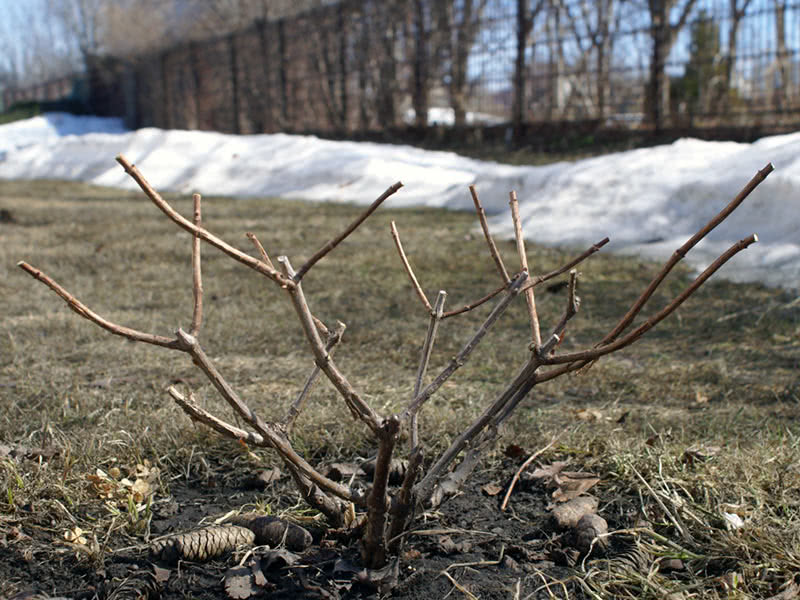
Bush after pruning in autumn
In the fall, faded brushes are cut off so that the branches do not break off under the weight of the snow cover, and sanitary pruning is carried out. Extra branches are not removed, since it is impossible to predict in advance how the plant will endure the winter cold.

Pruning is done with a well-disinfected tool.
Growing conditions
Pinky Winky hydrangeas are considered quite demanding plants. Their health, appearance and quality of flowering largely depend on the conditions in which they are grown.
When planning to plant this flowering shrub on the site, you should take responsibility for choosing a planting site, and also take into account the plant's requirements for soil characteristics and lighting
Site selection and soil preparation
When choosing a place for planting hydrangeas, you should give preference to moderately lit corners of the garden. It is allowed to plant them in light partial shade. It is undesirable to choose open places for planting where the plants will be in direct sunlight all day. Under the scorching sun, the leaves and flowers of hydrangeas quickly fade, as a result of which the bushes lose their attractiveness. With a strong lack of sunlight, plants will grow slowly and develop less well. In addition, a lack of lighting will negatively affect the quality and duration of their flowering. Growing up in strong shade, shrubs will quickly lose their decorative effect.
The optimal place for planting hydrangeas is in such areas of the garden, in which the plants will be protected from direct sunlight. These can be places with a light sparse shadow falling from trees or buildings.
It is important to consider the type and parameters of the soil on the site. Hydrangeas, like most other horticultural crops, prefer acidic, slightly acidic and neutral soils with a high humus content.
Air and temperature
One of the features of panicle hydrangeas is their gas resistance. The ability of these perennials to tolerate air pollution allows them to be used both in urban landscaping and in the design of sites located in areas with unfavorable ecology. At the same time, these flowering plants do not tolerate drafts well. For this reason, experienced gardeners recommend placing them in windproof places where they will be protected from strong winds.
Another important feature of the presented variety of hydrangeas is frost resistance. These plants are able to withstand a drop in air temperature to -25-26 ° С without any unpleasant consequences.

Hydrangea paniculata Pinky Winky - planting and care

There are nuances in growing Pinky Winky that a novice florist should know about in advance, although at first glance everything seems pretty standard.
Seat selection
Pinky Winky hydrangea has a well-developed root system that lies close to the soil surface. This means that when choosing a site for a flower, it is worthwhile to immediately allocate a permanent place, since it will not tolerate frequent transplants.
In the heavily shaded flower beds, Pinkie Winky blooms weakly, and the petals of its buds become pale. At the same time, the scorching sun can cause burns on the leaves. Therefore, you need to choose places with shade, but well-lit half of the day.
The growth of hydrangeas is negatively affected by the proximity to plants that have a superficial root system, since the shrub will not have enough nutrients. It is worth considering carefully the choice of Pinkie Winky's "neighbors".
Pinky Winky feels good in all climates. It blooms beautifully in the mountains of the Urals, and in the Leningrad region, and even in the Far East. But especially lush and long flowering will delight amateur gardeners in the southern part of Russia, since there are more warm days here.
Hydrangea is moody about the quality of the soil. She needs loose and light soils.Only acidic soils with a pH level of 4.5-5.5 are suitable, alkaline and neutral Pinky Winky soil is not recommended. But if there is no other option, then it can be flavored with peat or a special agent (for example, esid).
Plants prefer only fertile soil, so it needs to be constantly fertilized. Experienced gardeners recommend periodically making organic fertilizing.
Planting and caring for Pinkie Winky's panicle hydrangea requires attention and knowledge.
The plant requires a site well lit by the sun's rays. The shrub does not tolerate direct sunlight, so it should be planted near buildings or tall trees.
Hydrangeas need a lot of moisture. Watering should be done regularly. In hot weather, the soil should always be well moistened. In order to preserve the moisture reserve, the soil around the shrub is mulched with peat, pine needles or cut grass.
The plant can be planted at any time. The plant develops most actively after planting in the spring. In addition, by winter, the bush will be able to get stronger and develop the root system well.
For planting, you should prepare a landing pit 50 centimeters deep. Before planting, the roots of the plant are shortened and the shoots are cut off. This will help form a lush and beautiful plant.
The soil mixture must necessarily include peat, humus, coarse sand and last year's foliage. It is recommended to add spruce needles. You can add ready-made potting mix for azaleas or hydrangeas to the planting hole.
Water should be added to the planting pits, the seedlings should be placed and pressed with your hands. When planting, the root collar should be at ground level. Then the plant is watered abundantly, the soil in the near-stem circle is mulched with sawdust or peat.
Plant feeding is carried out twice a year: in early spring and late autumn. For this, a complex mineral fertilizer is used.
Pinky Winky hydrangeas tolerate winter frosts down to minus 25 degrees without additional shelter. Young shrubs can be prone to freezing, so care should be taken to prepare the plants for winter. Spruce branches, burlap or non-woven fabric can be used as a covering material. The trunk circle should be covered with dry leaves or peat.
To form a shrub, pruning should be carried out regularly, which will help to form a beautiful crown, prevent its thickening and allow you to remove dried branches. Pruning hydrangeas stimulates the development of young shoots. Pruning is done in the spring. The outer branches should also be shortened into two pairs of buds.
The shrub grows poorly in an area that practically does not receive sunlight. This makes the flowering weak and the flowers themselves pale.
It is impossible to allow direct sunlight to fall on the hydrangea, since this inflorescence will lose their decorative qualities, and the leaves will receive burns.
You cannot plant it in windy areas, because heavy panicles will break off and the plant will look unsightly.
Hydrangea grows poorly in sandy soil or in soil with an alkaline or neutral reaction. She prefers an acidic environment. To do this, peat can be added to the soil. Before planting, the soil is carefully dug up and rotted (not fresh) manure is introduced into it. It is forbidden to add lime.
Reproduction of Pinkie Winky hydrangea
Before planting, it is also worth deciding directly on the type of reproduction of the future hydrangea bush. Modern summer residents tend to adhere to two main types of reproduction: seed and cuttings.

Reproduction Pinkie Winky
The seed type is considered to be more professional: it will not be adhered to by amateur gardeners, but by experienced flower growers and breeders. Propagation of hydrangea by cuttings is a less time-consuming process.
Cuttings
First, it is worth collecting planting material, which can be obtained, for example, from neighbors during the pruning of the plant in the summer during the formation of inflorescences.After the removed shoots, it is necessary to prepare pieces with several (preferably two) nodes, then deepen the plant into a container with the mixture by two to three centimeters and water. When the shoots take root, the hydrangea needs to be transplanted into the open ground in the garden.
Healthy. Seed propagation is used extremely rarely, even for production purposes. This method is laborious, the result is not always pleasing, since flowering shrubs will appear from the seedlings after 2-3 years.
Layers
In early spring, soil is dug around the bush, fertilized and spilled. After that, the shoot is bent to the ground and "pinned". You can sprinkle it with earth right away, you can do this in a few days. By the end of August, young shoots will appear from the rooting site. Closer to October, each shoot is separated and buried in soil.
Care Tips

- You need to water the hydrangea of this variety regularly in order to subsequently obtain abundant flowering. Pay particular attention to the humidification schedule during the hottest summer period. The soil should not dry out.
- In summer, water 17-20 liters of water several times a week, and in autumn and spring at least once every 2 weeks. To prevent moisture from leaving, mulch the area in the peri-stem circle with sawdust, bark, peat or spruce needles with a layer of about 10 cm.
- Top dressing must be carried out constantly. In the spring, add trace elements (3 grams per 1 kg of soil), nitrogen-containing preparations contribute to the development of the root system and foliage. Before the flowering period, be sure to feed with enough phosphorus to set the buds and flowers.
- In the autumn months, it is necessary to add potassium so that the plant successfully endures the winter and maintains strong immunity.
- Pruning should be in the spring: dried and rotten branches after winter, frozen or affected, as well as growing deeper into the bush and unnecessarily thickening the crown.
- After flowering, dried inflorescences should be removed from the bush so that the shoots do not break under their weight.

How to plant a flower?
Planting this variety is worth depending on the location. If your garden plot is located in the northern area, then the most optimal time for planting is spring, if the summer cottage is located in the southern strip, then you can plant in spring and autumn. It is necessary to plant the bushes at a distance of 1-2 m from each other, while the root collar should not be buried. The hydrangea rhizome is not very deep, but rather branched. Immediately before planting the plant, you need to dig a hole 30 * 30 * 30 cm in size and add half a bucket of a mixture of humus and peat into it, then water the hydrangea abundantly with water. It is better to take soft water for irrigation, preferably rainwater or settled. After watering, the land should be loosened up so that it can be saturated with oxygen.
The planting site can be either sunny or slightly shaded, since this plant is shade-tolerant. The only unfavorable factor can be only a strong wind, which will not only pluck small delicate hydrangea flowers, but also significantly affect its general condition. The bright midday sun also negatively affects the growth and flowering of hydrangeas: its flowers become paler, and the bush itself will not be so lush and luxurious. The only thing that can be done in this case is to increase the frequency of watering and constantly monitor the soil moisture. When choosing a place to plant a plant, you should opt for empty areas, where the rhizomes of trees and other large shrubs will not prevent it from growing and delighting your eyes for many years.
The length of the Pink Lady hydrangea shoots must be adjusted every year, and the soil must be periodically mulched with sawdust, pine needles or peat. All this is necessary in order for moisture to be retained in the ground for as long as possible. Due to frequent watering, the soil near the shrub can often be seized by a crust.In this case, it is imperative to carry out loosening, grabbing the soil around the shrub within a radius of 50-70 cm, and at the same time removing weeds. The biological feature of the Pink Lady hydrangea is that under its very high ground part there is a root system that grows horizontally. It is because of these features that the plant needs constant moisture so much. It is also worth loosing the soil quite carefully so as not to damage the rhizomes of the hydrangea.



